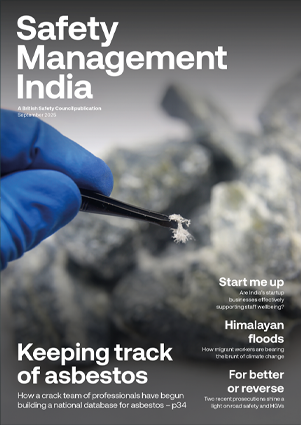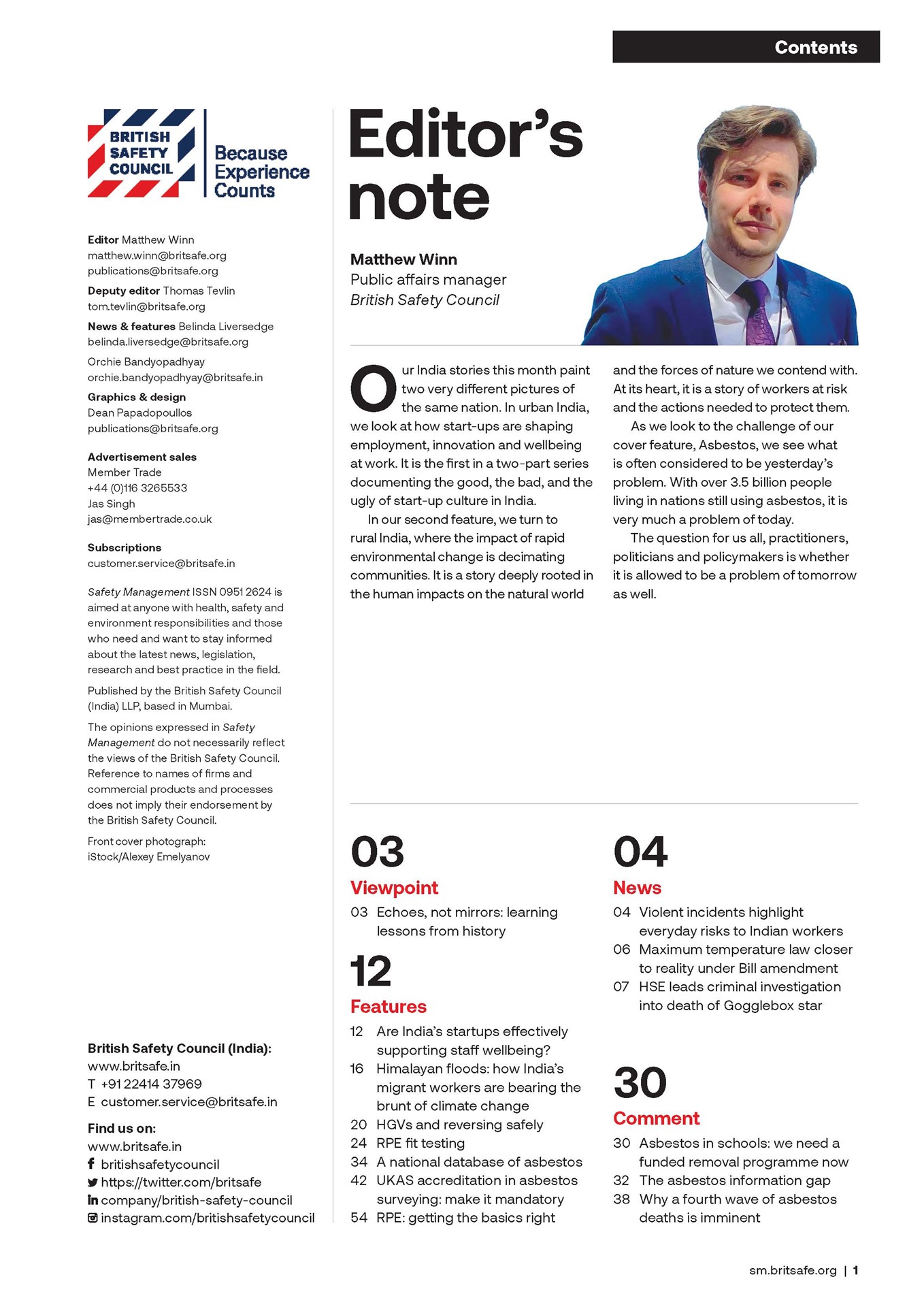Mobile apps are playing an ever-greater role in helping to keep people safe at work, with Indian universities and industry working closely together to develop the required technology.
Features
There’s an app for that
A man from Bihar in his 30s who was working at the site of an under-construction bridge in Shahapur, about 80 kilometres north of the city of Mumbai in the western state of Maharashtra, is being hailed as extremely lucky after miraculously surviving a nearly 115-feet fall.
The incident, which occurred on 31 July, left 20 workers, mostly construction labourers and site engineers, dead after a giant crane collapsed on them during construction of the third phase of the Samruddhi Expressway. However, Prem Prakash’s harrowing ordeal has left officials astounded and witnesses in awe.
Along with another labourer, Prakash was over 100 feet up on one of the bridge’s piers when a concrete girder and a launcher gantry crane collectively weighing almost 2,000 metric tonnes collapsed from a height of 35 metres. He was trapped under the launcher for almost half an hour before villagers pulled him out of the wreckage. Prakash was then quickly transferred onto a vehicle and taken to hospital.
Although Prakash escaped with only a fractured right leg, officials said the incident represented his worst and best day both on the same day. “His worst day is falling, and his best day is the fact that he survived and will live to go back to his village,” said an official.
Even Prakash is struggling to come to terms with the fact he survived the tragic incident which claimed the lives of so many of his co-workers.
The news of his remarkable survival resonated deeply with the families of other workers, who tragically lost their loved ones in the incident.
Prakash has filed a police case alleging carelessness on the part of subcontractors working for Navayuga Engineering Company Limited and VSL India Limited, the two companies in charge of the project to build the 2.38 kilometre-long bridge for the new expressway. Prakash had been working for contractors employed by VSL for the past eight months.
Although the investigation into the crane and girder collapse continues, the incident emphasises the importance of maintaining a vigilant approach to workplace safety and is a poignant reminder of the dangers posed by working at height.
The construction industry has not always been at the forefront of making technological advancements in health and safety, perhaps due to concerns about the cost of research and development, and the risk of accidents and ill health occurring while the technology is being trialled.
However, commentators say construction companies should consider developing and using technology like apps as they offer the opportunity to boost health, safety and efficiency across all areas of site operations.
 Photograph: iStock- credit-lakshmiprasad S
Photograph: iStock- credit-lakshmiprasad S
Emerging tool
In fact, mobile apps are increasingly viewed by experts as one of the most important emerging tools for improving workplace health and safety, and their usage and scope is expected to grow hugely in coming years.
For instance, researchers at the Indian Institute of Technology Delhi (IIT Delhi) are developing a Smart Monitoring System (SMS) to detect and alert workers about unsafe conditions while working at height.
Karam Safety Private Limited (KSPL), one of the world’s leading fall protection companies, and FITT (Foundation for Innovation and Technology Transfer) at IIT Delhi, which acts as a research and technology development interface between academia and industry, have signed a memorandum of understanding for the development of the SMS.
“Falls from a height are one of the main causes of serious and fatal workplace accidents,” said Husain Kanchwala, a professor at the Centre for Automotive Research and Tribology (CART) at IIT Delhi.
“Most of these accidents occur when a worker is wearing the safety gear but forgets to connect it to the anchor point either due to habit or in a hurry to complete work. In order to monitor whether the safety procedure for working at height is followed by the worker, we have proposed an SMS.
“If the worker has not connected the safety gear while working at height, the system will alert the user by an audible warning alarm and also communicate to the supervisor and the safety person in-charge via an app,” he added.
Sunil Jha, a professor at the Department of Mechanical Engineering at IIT Delhi, explained the SMS aims to detect whether the user has correctly connected themselves to a suitable anchorage point while working at a height to prevent or arrest their fall. It is also hoped that the technology will have a tracking function so it can record repeated safety violations by users while working at height. The results will then be used to improve or reinforce safety training and if necessary offer counselling to workers.
Alarm app for migrant workers
Meanwhile, following incidents of aggression and violence towards migrant workers in Tamil Nadu earlier this year, students at Sona College of Technology in the southern state have developed a mobile app designed to help ensure the safety of migrant labourers.
The ‘Migrant Care’ app aims to connect the workers, their agents and police officials to provide immediate assistance in the event of migrant workers suffering any distress, threats, aggression or violence.
The app features a ‘I am not safe’ button, which allows workers to send a distress signal if they are in need of help. Alternatively, they can also mark themselves as ‘Safe’. The messages sent through the app can be viewed by police officials in real-time, thanks to the geolocation feature incorporated in the app.
The development of the app was initiated by B Vijayakumari, IPS, the commissioner of police for Salem City, who asked the students to develop a technological solution to help ensure the safety of migrant workers. The BTech-IT students successfully developed the app in less than two days, under the guidance of Dr J Akilandeswari, Dean of academics and professor of IT at the college.
Since its launch, the app has proved popular among migrant workers in Salem. Out of an estimated 4,000 migrant workers in the area, nearly half of them downloaded the app within the first few days. The students are now testing the app to see if it could have a wider reach and exploring its potential use in other emergency situations.
Chocko Valliappa, vice chairman of Sona Group of Institutions, said: “At the Sona College we encourage our students to apply their latest technical knowledge and skills in helping our communities. The easy to-use ‘Migrant Care’ application empowers migrant workers to feel and stay safe with the help of district police officials.”
Students are also exploring additional features that can be incorporated into the mobile app in light of input from the police department.
Meanwhile, after the country witnessed the mass movement of migrant workers back to their home states, towns and villages following Prime Minister Narendra Modi’s announcement in spring 2020 that the entire country of 1.3 billion people would be under lockdown to prevent the spread of coronavirus, an app for the safe and smooth movement of migrant workers across the country was launched by Caritas India, the social service arm of the Catholic Bishops’ Conference of India.
The mobile app, dubbed Pravasi Bandhu, can be downloaded from the Play Store on an Android mobile phone, and helps migrant workers access information about their rights and the procedure for registering to gain access to social security and health benefits.


FEATURES

Delhi’s air pollution problem leaves construction workers jobless and without pay
By Orchie Bandyopadhyay on 10 November 2025
Every autumn and winter, Delhi experiences terrible air pollution that places the health of its 40 million residents at grave risk. But government measures to alleviate the problem by temporarily closing construction sites mean hundreds of thousands of daily-wage labourers are being left without wages and a means of financial support.

India’s road rage crisis: how professional drivers are bearing the brunt
By Orchie Bandyopadhyay on 10 November 2025
High profile reports of violent attacks on people who drive for work purposes, like bus and delivery drivers, have shone a spotlight on the growing problem of road rage in India. Commentators say it is now time for the Government to step up prosecutions of those who act aggressively on the road, while educating drivers on stress management techniques, to tackle the problem.

